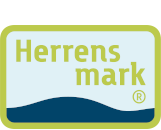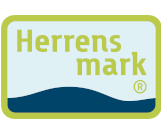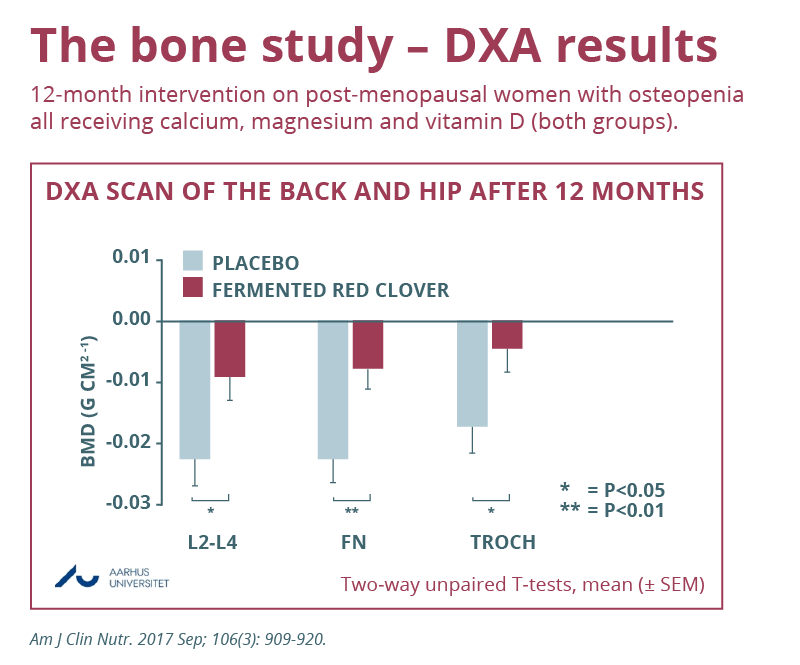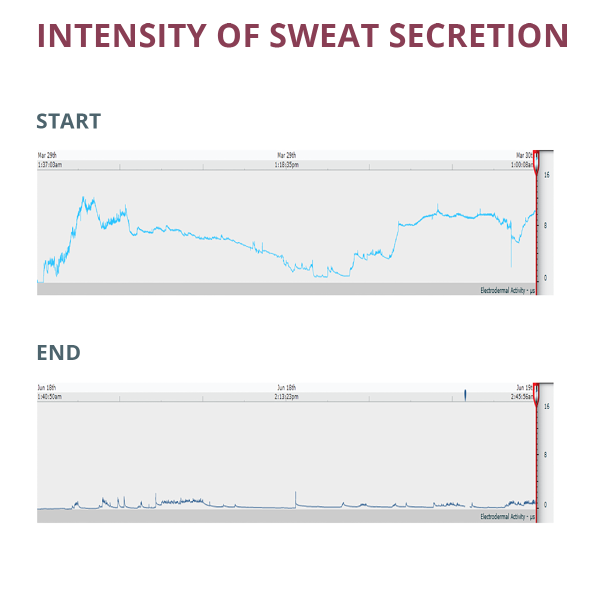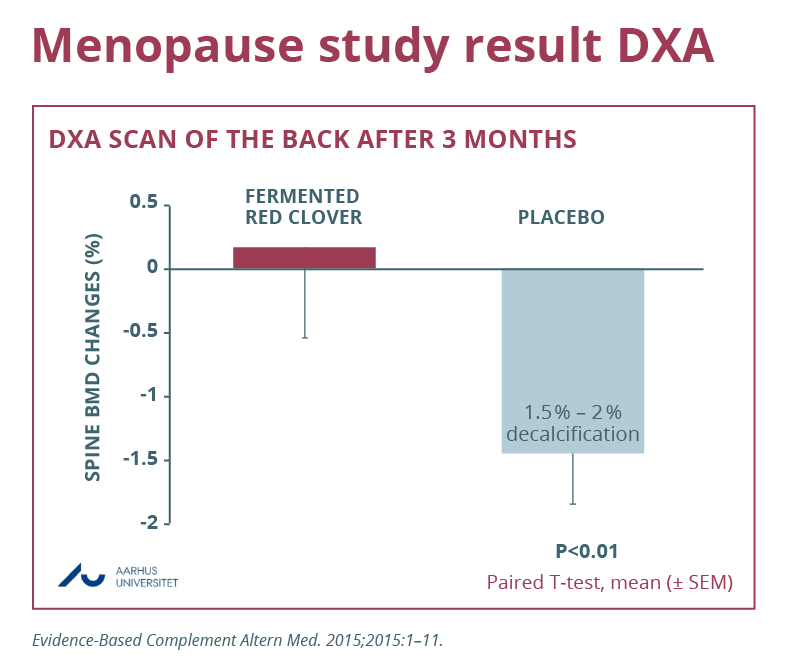Fermented red clover slows oestrogen-related bone loss in women
Read the articles:
doi.org/10.3945/ajcn.117.153353
doi.org/10.1371/journal.pone.0176590
Resumé:
The bone-preserving effect of REGOROS, fermented red clover extract, was studied in a scientific double-sided placebo-controlled trial conducted over 12 months in which 78 women participated. All participants were aged 60+ and diagnosed with osteopenia, i.e. a reduced bone density of between -1 and -2.5. The women were divided into two groups: one given REGOROS and one given a placebo. All participants also received a daily supplement of calcium, magnesium and vitamin D. Bone scans were performed, and blood samples were taken at the beginning and end of the trial.
After the 12 months, bone scans of the spine (L2 to L4) and the hip bone (trochanter) determined that those who had been given fermented red clover extract had a significantly lower bone loss. Decalcification after taking fermented red clover was at the level that is normal before menopause. In other words, the women who received fermented red clover experienced a slowdown, whereas the women in the placebo group had an average bone loss of about 3%.
From the age of 35-40, bone strength gradually begins to decrease. Menopausal women are particularly susceptible to loss of bone density as oestrogen levels fall during that period of life.
The blood samples also showed signs of that the activity of bone-resorbing cells had decreased among those who had received red clover. Due to the aglycone form of the fermented red clover, they had also developed a better oestrogen metabolism.
In summary, the study showed that REGOROS reduced bone loss and had a positive effect on bone metabolism as a whole.

The average change in bone mineral density (BMD) between the control and the red clover group in measurements of L2-L4 (lumbar vertebrae), FN (femoral neck) and trochanter (hip).
Sources
-
Lambert MNT, Thybo, CB, Lykkeboe S, Rasmussen LM, Frette X, Christensen, LP, Jeppesen PB (2017): “Combined bioavailable isoflavones and probiotics improve bone status and estrogen metabolism in postmenopausal osteopenic women: a randomized controlled trial”. The American Journal of Clinical Nutrition, Vol 106, Issue 3, September 2017, pp. 909-920. https://doi.org/10.3945/ajcn.117.153353
-
Lambert MNT, Thorup AC, Hansen ESS, Jeppesen PB (2017): “Combined Red Clover isoflavones and probiotics potently reduce menopausal vasomotor symptoms”. PLOS ONE 12(6): e0176590. https://doi.org/10.1371/journal.pone.0176590
https://videnskab.dk/krop-sundhed/knogleskoerhed-kan-stoppes-med-roedkloever
Combination of red clover isoflavones and probiotics effectively reduces hot flushes and sweating intensity in menopausal women
Read the article:
doi.org/10.1371/journal.pone.0176590
doi.org/10.1155/2015/689138
To investigate the effect of REGOROS on menopausal symptoms, Aarhus University Hospital initiated a 12-week, double-blind, randomised and placebo-controlled study in 60 women with severe menopausal symptoms. Half of the women were given REGOROS, while the other half was given a placebo.
Throughout the study, the participants wore a specially designed sensor that measured their hot flushes and sweating 24 hours a day. The aim was to be able to objectively assess the frequency and intensity of the participant’s hot flushes and sweating. The participants were also instructed to keep a diary of their hot flushes and to complete regular questionnaires regarding their menopausal symptoms. 24-hour blood pressure readings were taken, and regular blood tests were performed to measure lipid levels and biomarkers that determine their menopausal status.
In addition, bone scans (DXA) of the femoral neck and lumbar vertebrae were performed as well as measurements of biomarkers of bone loss (CTX) at the beginning of the study and again at the end.
Close to 10% reduction in bone loss
After the 12 weeks, the researchers observed a clear tendency for decreased turnover of plasma CTX among those who had received REGOROS (high CTX values indicate increased bone loss). Plasma CTX in the REGOROS group was thus reduced by 9.94% at the end of the study. This showed that REGOROS helped maintain bone density and reduced bone loss.
Bone scans (DXA) of the lumbar vertebrae showed that, after 12 weeks, Bone Mass Density (BMD) in the lumbar vertebrae of the red clover group had, on average, increased, whereas the group that had received a placebo had lost BMD.
Bone scans of the femoral neck showed that BMD had decreased in both groups. However, the decrease was significantly lower in the participants who had received red clover than those who had received a placebo.
Significant reduction in frequency and intensity of hot flushes
The sensor measurements showed that the frequency of hot flushes in the participants who had received REGOROS had reduced by 23.5%, and the intensity by 38.84%. This was also confirmed in the participants’ diaries, where they estimated that the frequency of their hot flushes decreased by an average of 30.69%.
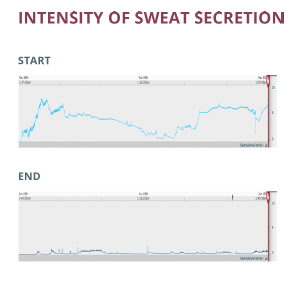
Example of a 24-hour data set for skin conductance showing baseline (top) and after 12 weeks of treatment with red clover (bottom). Skin conductance is an indication of the amount of sweat, as moisture increases the skin’s conductance level.

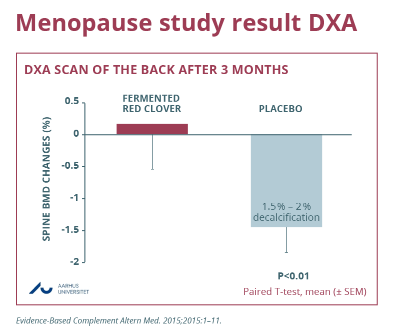
The effect of aglycone isoflavone preparations on bone loss due to oestrogen deficiency in menopausal and postmenopausal women
Read the article: doi.org/10.3945/ajcn.116.151464
Isoflavones have a structure reminiscent of oestrogen. Several clinical trials have therefore also been conducted with isoflavone preparations and their effect on women’s health during and after menopause.
Recent studies, however, show that the bioavailability and absorption capacity of the isoflavones play a crucial role in their effectiveness. The reason for this is that isoflavones are naturally bound to sugar molecules, and in order to be absorbed into the body, they have to be separated from the sugar molecules.
Lactic acid fermentation is an effective method of separating the sugar molecules in isoflavone preparations. When the preparations are fermented, the isoflavones and sugar molecules are separated, resulting in aglycone-isoflavone preparations.
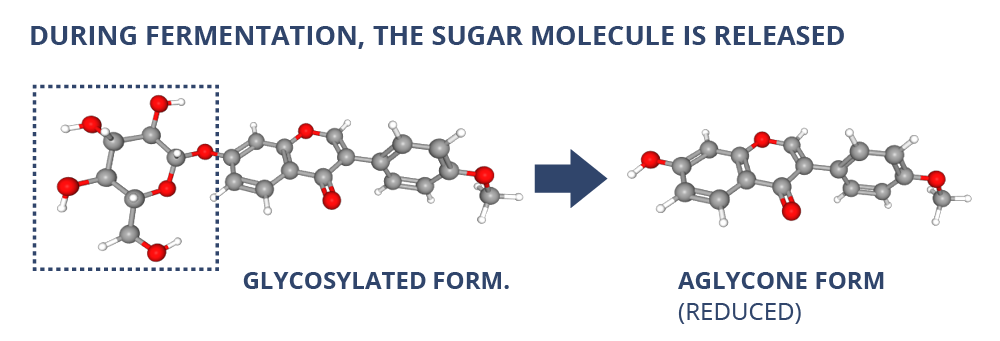
In previous studies at Aarhus University Hospital, REGOROS, fermented red clover extract (isoflavone aglycones) showed an ability to slow bone loss during and after menopause. To investigate whether this was also the case in other studies, the researchers conducted a meta-analysis (a statistical method of summarising and evaluating studies, research questions, and comparable criteria) of the research conducted on isoflavones and treatment of bone loss during and after menopause.
Conclusion: significantly less bone loss as a result of isoflavone aglycones
The meta-analysis included studies conducted up to December 2016, which also used randomised controlled trials. The comparison was made on the results of bone density measurements (DXA scans) of the lumbar spine and femoral neck, as well as the effectiveness of aglycone-isoflavone preparations versus non-aglycone preparations). The patients were treated with soy and red clover respectively, which was taken either in food or drinks or as a supplement (tablets, capsules and powders). The daily dose of isoflavones was documented./p>
Out of 1,544 potential studies, 26 met the criteria, which were subsequently examined in greater depth. 2,652 women had participated in the studies, mainly after menopause. The results confirmed that isoflavones effectively prevent bone loss during and after menopause as long as they are ingested in an aglycone form. Study participants who had taken these preparations showed significantly better results on measurements of bone scans of the lumbar spine and femoral neck than the control groups (placebo).
Sources
-
Lambert MNT, Lin MH, Jeppesen PB (2017): „A systematic review and meta-analysis of the effects of isoflavone formulations against estrogen-deficient bone resorption in peri- and postmenopausal women”. American Journal of Clinical Nutrition Vol. 106. Pp. 801-811.
https://doi.org/10.3945/ajcn.116.151464
